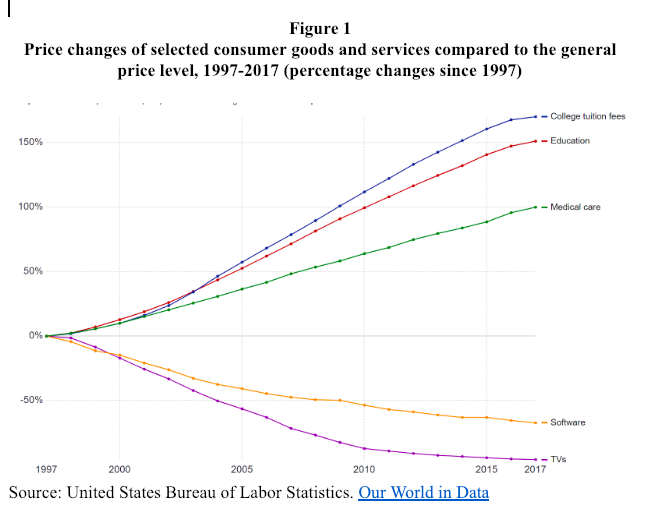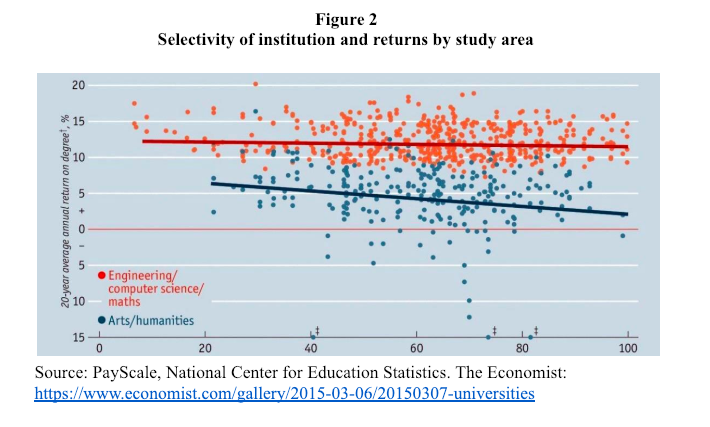How Government Ruined Higher Education
The rise of the costs of the American higher educational system began when expansion became the aim of education policy. The new objective was to have as many students as possible in college. Students’ increased ability to pay, which came with easy access to student loans, allowed universities and colleges to raise prices and to invest in areas such as sports and recreational facilities that had little to do with education but made campus life more attractive. Inasmuch as private universities also depend on public subsidies, the whole university system has come under the control of the state and must meet the criteria set by it. The current system puts pressure on the young to go with the crowd. While the costs keep on rising, the benefits fall.
Cost Explosion
The costs of a university education have risen much more than the general consumer price index and unregulated consumer goods and services. Along with medial costs, college education and textbook prices show the highest increases.
Many college campuses have become more like amusement parks than places of higher learning. As it is no longer the academic program that is the focus of university administrators’ attention, but the quantity of students, the proportion of part-time instructors and substitute teachers has expanded at the expense of qualified professors. The number of administrative staff has risen along with their salaries, and the compensation of directors and coaches of sports teams has skyrocketed because, more than academic achievement, entertainment serves the “branding” of the institution.
Education, instead of being an instrument of liberation and intellectual advancement, has fallen in quality. While students’ financial burden is on the rise, their return in terms of higher salaries is falling. Along with the host of other public-services systems, the modern state-run educational system has become a trap. Young people feel obliged to get a degree, and when they have one they must land a well-paid formal job to be able to finance their student debt. Yet the prospects are getting grim.
Signaling
Over the past several decades, social pressure has arisen for the young to go to college, including those who do not want to study or who are not qualified for a university education deserving of the name. Students yield to the pressure because degrees have become the primary criterion for employment, particularly at the entry level.
The modern university system would collapse if employers discarded their use of academic degrees as a screening device. Studies show that a college education has become an outstanding vehicle for gaining employment. Yet what counts as the criterion to gain employment is not the knowledge gained from studying but the getting of the degree. The diploma serves as an indicator of discipline, endurance, obedience, and an acceptable level of intelligence — traits that employers value — and that is more important than the content of the academic instruction. This is not unknown to students who care less about what they learn in a course than how to pass and to get the desired diploma. Tests confirm that students remember little from their coursework once they have passed their exams. This does not matter much for employers, because most of the teaching is irrelevant or of little use in most workplaces.
Empirical studies (figure 2) show that the role of the prestige and selectivity of educational institutions has only a small effect on the lifelong income of graduates. Not where one has attended but which area one has studied counts for personal earnings. Graduates from the more selective institutions earn somewhat more, but the big gap exists among the fields of study.
As the numbers show, there are no significant pay differences over time between graduates of the low-barrier colleges and graduates of the selective universities. The main divergence in income comes from the discipline the graduate studied and not from the admission rates of the university. Students who hold degrees in technical and mathematical disciplines earn a higher income than those who study the humanities, irrespective of the status of the university where they studied. The fact, as one might assume, that at the more selective universities students learn more, is irrelevant for the earning potential of the graduate.
The inquiries that show that college graduates earn more than those without a degree are correct, yet they ignore that this unequal distribution of income would also have come about had these more talented and more dedicated persons not attended a university.
A higher academic degree serves to get a higher individual salary. More education for the individual means that one can outcompete those with lower degrees. For the cohort, however, more education does not provide a similar advantage. The larger the proportion of people in each age group that go to college and the higher their level of formal education, the more the relative costs per student increase while the average level of qualifications diminishes.
Boundless Demand
Education is a so-called superior good, for which the demand rises more than proportionally to income. This would be no problem if the beneficiaries themselves were to bear the costs. It is different, however, with government-subsidized education. The recipients of the service are not the same as the people who pay. An excessive demand is the result, and overconsumption occurs. The costs explode because neither the buyer nor the supplier controls them. Demand is individual, but the costs are largely borne by the collective. The logic of such a system drives the system to expand and to increase in cost.
In the educational system, the interaction of demand and supply works not as an equilibrating process but as an accelerator toward an avalanche of expenditures. If everyone were a self-payer, with no subsidies, the providers would have to focus on the ability to pay of the individual. In a free market, the role of universities and schools as diploma factories would end and different forms of education would emerge. Yet because the state acts as a provider that delivers the goods for free or at a subsidized price, fully private suppliers of education cannot effectively compete. In the United States, about 30 percent of all students attend so-called private colleges and universities.
Yet with few exceptions, such as Hillsdale College, almost all educational institutions depend on broad financial government support. The many overt and hidden subsidies — such as federal student loans, a wide gamut of tax allowances, and research grants — make the “private universities” de facto public institutions.
Because of the quasi-monopolistic position of the public educational institutions, the offers from private suppliers are crowded out. The private supply shrinks, although it would be better and cheaper than the public provision. Education suffers from the same dilemma as state-run health care: the potential for cost saving remains unfulfilled since no incentives for efficiency exist. In order to get the subsidies and the other benefits from government, the universities must adhere to specific bureaucratic rules. Such governmental criteria also apply to the research output and provoke indirect state control and outright corruption.
The problem with the modern educational system is that it has fallen under the authority of the state. Therefore, the system has become more bureaucratic and authoritarian and less scholarly and educational. Disguised as a public good of social value, education has evolved into a billion-dollar industry whose main benefactors are not the students but the organized providers of educational services.
Conclusion
In the present system, the overall costs of education exceed its marginal benefits. The absence of the price system in education has eliminated cost control. The modern state-run and state-certified system of education does not make the economy more productive. The function of education is signaling, as employers use educational performance as an indicator of general intelligence, perseverance, and conformity. For this purpose, the costs are too high. The real costs remain hidden because they are mainly borne by the public.
It is not more regulation, but a retreat of the state from higher education, that is the answer. In a free market for education, more investment would go into gaining specific skills. Specialized institutions that cooperate with employers would emerge where one could acquire marketable skills. Young people would not spend years as college kids and waste much of their time on studying useless subjects only to enhance the signal of their employability.













